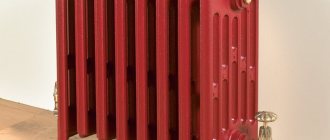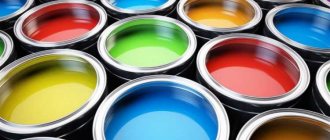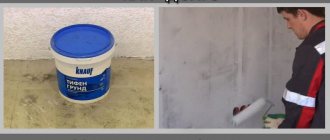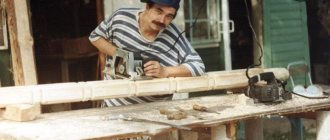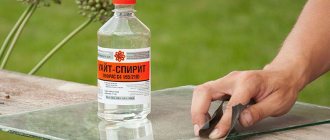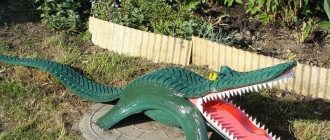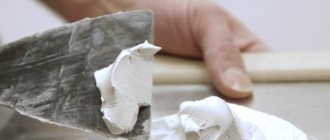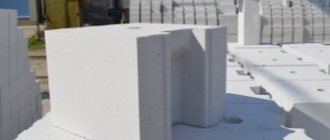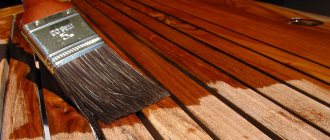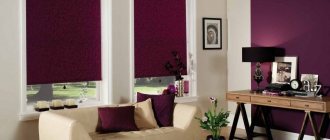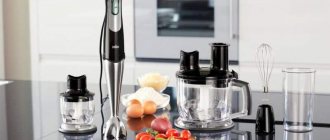Peculiarities
Alkyd enamel appeared relatively recently and in a short period of time was able to gain popularity, displacing other types of paint and varnish coatings.
This product is distinguished by its versatility, due to which it is actively used not only for interior work (finishing floors and walls), but also for exterior repairs.
The defining difference between alkyd enamel and acrylic enamel is resistance to mechanical damage, as well as the ability to perfectly resist abrasion. Even after many years, the surface finished with alkyd enamel continues to retain its attractive appearance.
Thus, among the main features of this type of enamel one can highlight its impressive elasticity and durability.
The material requires a minimum amount of time to dry, so it can be used in any room.
Another advantage of this type of paint coating is that it does not turn yellow over time and does not lose its original color.
Marking
In order to correctly select the required alkyd enamel, you should familiarize yourself with the markings, which indicate the scope of its application:
- Alkyd primer – 0;
- Suitable for exterior decoration – 1;
- Alkyd paint for interior work – 2;
- Used for conservation work – 3;
- Alkyd waterproof enamel – 4;
- Special purpose – 5;
- Increased resistance to petroleum products – 6;
- Suitable for providing protection against aggressive environments – 7;
- Resistance to temperature changes – 8;
- Used for painting electrical wiring – 9.
Characteristics
The unique characteristics of alkyd enamel make it possible to use it during work outdoors, since the material is not afraid of the influence of rain and snow, temperature changes and the rays of the sun. The product contains cutting-edge components that provide reliable protection of the material from the corrosion process.
This is why it is actively used for finishing metal and wooden objects.
Among the most popular options are the following varieties:
- Quick drying. In most cases, it contains driers and various solvents. Thanks to this, the drying process takes a minimum amount of time, which makes alkyd enamel an ideal solution for interior decoration.
- Melamine-alkyd. The peculiarity of this material is that this variety boasts impressive adhesion, which is why melamine alkyd types are used for painting metal.
- Alkyd-urethane. It is a mixture of pigments and targeted additives, which also includes special driers.
Alkyd enamel is obtained by mixing alkyd varnish and special solvents. However, other components can also be added to the paint: to give a certain color, to provide corrosion resistance and other additives.
If it is necessary to ensure the resistance of the material to various fungal infections and prevent the development of mold, then antiseptics are added to the product composition.
It should be noted that, like most other paints and varnishes, enamel, if not used for a long time, can lose its properties and change consistency, which can only be returned by adding a special solvent.
The main component of such enamel is alkyd varnish, which can be of two types:
- Pentaphthalic is a special resin composition to which glycerin and natural oils are added. The main advantage of this component is that it boasts its resistance to water.
- Glypthal. The composition has a high drying speed, which varies from 24 to 6 hours.
paints and varnishes
0 votes
+
Vote for!
—
Vote against!
There are a great variety of alkyd enamels. This paint coating is distinguished by its versatility, abrasion resistance, and bright colors. It can be used for both interior and exterior work, and due to the fact that alkyd enamel paint can be glossy, matte, or semi-matte, its scope of application is almost limitless.
Content:
- Composition of alkyd enamels and their properties
- Features of alkyd enamels
- Classification of alkyd enamels
- Alkyd enamel GF-230
- Alkyd enamel PF-133
- Alkyd enamel PF-115
- Alkyd enamel PF-223
- Alkyd enamel PF-253
- Alkyd enamel PF-126
- Matte enamels
- Aerosol enamels
- Manufacturers of alkyd enamels
Composition of alkyd enamels and their properties
Alkyd enamels are made on the basis of alkyd varnish and various solvents with filler. In addition, they contain coloring pigments that give the coating a certain color. Sometimes the manufacturer may include various additives in the combination, for example, antiseptics that protect the painted surface from mold and fungal infections. The main solvent for alkyd enamels is white spirit. By the way, this is what you should use if the paint has thickened. And the fillers are usually sand, granite or marble chips and other materials that have the same properties. Fillers for paint and varnish coatings should not be confused with traditional sand and crumbs - their grinding is much finer and the structure of these materials is more similar to flour.
The most important component of alkyd enamels is alkyd varnish, which comes in two types: pentaphthalic and glypthal. Most often, in the production of paints, pentaphthalic varnish is used, which is a thick solution of resin in a solvent with the addition of vegetable oils, rosin and glycerin. The finished varnish is later mixed with a solvent to form an alkyd enamel.
Features of alkyd enamels
The features of alkyd enamels include their high elasticity and durability. Such coatings dry quickly enough, which allows them to be used indoors without much concern. In addition, such paints do not turn yellow when dry, do not lose their color, or shrink.
They are also suitable for outdoor work, since they have high weather resistance - snow, rain, and temperature changes are not a problem for alkyd enamels.
This type of paint coating perfectly protects various metal surfaces (doors, windows, radiators, furniture, etc.) from corrosion; it is also able to withstand wet cleaning with conventional detergents and can be used in bathrooms, saunas and swimming pools.
Classification of alkyd enamels
Depending on the classification, alkyd enamels have different properties, methods and areas of application. Each brand has its own alphanumeric code, which allows you to determine whether the enamel belongs to a particular category. For example, alkyd enamel PF-120 matte white is deciphered as follows: PF - pentaphthalic (these letters indicate the substance that is used in the paint as a base); the number 1 means that the enamel can be used for outdoor work, and the number 20 is the catalog number.
In addition to the unit, other numbers can be found on alkyd enamels: the number “ 0 ” indicates alkyd primer enamel, that is, a coating intended for priming surfaces;
2 — enamel for indoor use (heated and unheated);
3 — conservation paints, that is, paints and varnishes that are intended for temporary sealing of any equipment;
4 - waterproof paints;
5 — special paints with special characteristics (rodent repellent, glow in the dark, etc.);
6 — oil and petrol resistant enamels;
7 — paints that can withstand chemical attack;
8 — heat-resistant paints;
9 — electrically conductive and electrically insulating paints.
Alkyd enamel GF-230
In this case, GF is glyphthalic. This paint is intended only for interior painting of ceilings and walls. It cannot be used for painting floors, since it does not withstand physical influences well. Before you start using the enamel, it must be diluted to the desired consistency with white spirit or turpentine. There are quite a few shades of glyphthalic enamel GF-230, ranging from light cream to dark colors. It can be applied with a brush, roller or spray. It dries in about a day and has a distinct varnish smell.
Alkyd enamel PF-133
It is used for painting metal surfaces or surfaces that have been pre-primed. It is usually applied in two layers, since its covering ability is not too high (ranging from 20 to 120 g/m2). Dries in 2 hours and comes in 15 subtle shades. In temperate climates, PF-133 enamel retains its protective properties for 5-6 years, and it does not crack or deform.
Alkyd enamel PF-115
Designed for exterior painting of metal, wood and other surfaces. This enamel needs to be applied in two layers, since its covering ability is not too high (30-120 g/m2). Available in 24 shades, applied by spray or brush, drying from 8 to 24 hours. Alkyd glossy enamel PF-115 has a pleasant shine, giving the surface a bright, rich color.
Alkyd enamel PF-223
Its scope of application is interior finishing of wooden and metal surfaces. This alkyd enamel is perfect for radiators - it has 17 shades to suit every taste, hides old paint well and withstands high temperatures well. Diluted to the desired consistency with solvent, gasoline or xylene. Drying time 30-36 hours. The smell is specific, pungent.
Alkyd enamel PF-253
Scope of application: pre-primed plank floors. Apply in two layers using a wide or medium brush. Diluted with turpentine or gasoline. Dries quickly (drying time depends on the thickness of the layer and the temperature inside the room). After drying, the surface acquires an even, flawless gloss.
Alkyd enamel PF-126
This type of enamel is sold complete with NF-1 filler, which accelerates hardening. Apply the paint with a brush or roller in two thick layers with intermediate drying of 30-40 minutes. Before application, the surface is primed with enamel diluted with white spirit.
Matte enamels
Sometimes matte alkyd enamel may be required to paint surfaces. As a rule, such paint is intended for both exterior and interior use. It is durable, resistant to water, detergents, and oils. Able to withstand temperature fluctuations from -50 to +60o C. It is economically consumed, as it has a high covering ability (90-180 g/m2). Diluted with solvent or white spirit.
Aerosol enamels
Aerosol alkyd enamel is easy to use, since there is no need for brushes and rollers, it fits well on any surface and dries very quickly (3-5 hours). It is able to penetrate into any cracks, so it is recommended to paint hard-to-reach places, and the scope of application of such paint is very wide: from garden furniture to stucco on the ceiling.
In addition to the above, there are other types of alkyd enamels, the purpose of which also applies to painting walls, ceilings, floors and other surfaces both outside and inside the house.
Manufacturers of alkyd enamels
On store shelves you can find a huge assortment of alkyd enamels, both Russian and foreign. How do the former differ from the latter?
Firstly, the majority of Russian manufacturers do not rely on packaging: paints are “packed” either in metal or plastic cans. Imported enamels, as a rule, have bright, attractive packaging that distinguishes “overseas” products from their Russian neighbors.
Secondly, a price of 200-300 rubles per liter jar is clearly not suitable for high-quality alkyd enamel, and these are the price tags that are sometimes found on shelves with Russian products. Imported analogues are many times more expensive.
Thirdly, expensive imported enamels contain only the highest quality components that have passed all kinds of tests. It is due to such “ingredients” that enamels produced abroad have virtually no odor, dry quickly, have a huge number of shades and are well distributed over the surface, leaving no streaks or smudges. For example, Tikkuril alkyd enamel "Miranol" is ideal for painting furniture, window frames, doors and even children's toys - its level of safety is so high. It is not yet possible to say something similar about Russian enamels, although our manufacturers have recently been trying to pay as much attention as possible to the environmental friendliness of their products.
When buying alkyd enamel, you should pay attention to its shelf life - the fresher the paint, the better and smoother the coating will be. Well, the most important thing is that you don’t need to chase cheap or expensive - choose the “golden mean” - you definitely won’t go wrong!
Classification of alkyd paints
Alkyd-based paints and varnishes have various characteristics that determine their purpose and application. Both paints for general use and special compositions intended for specific surfaces are produced.
On containers with enamel you can find an unusual combination - GF-230, PF-115 and others. What it is? This is a special marking used for ease of orientation in various types of alkyd paints.
Film former
An important component of enamel is the film-forming component. Such additives can be etrifthalic, pentaphthalic, xyphthalic.
Pigment
This is a special powder that makes alkyd paint opaque and acquires color. Can be either organic or inorganic. In addition to decorative, they perform a protective function.
Filler
Fillers are designed to make the paint more durable, viscous and opaque. The composition can contain silicates and carbonates. Organic fillers are also used as more dispersed ones.
Additives in the composition
Additives perform various functions, make the drying process faster, and increase the stability and plasticity of the composition. The stabilizer will evenly distribute the paint and prevent it from flaking.
Types of alkyd enamels by chemical composition
The short abbreviation on the can's label helps identify the base used to create the paint. There are several types of markings:
- GF – paint based on glyphthalic varnish;
- PF – enamel on a pentaphthalic varnish base;
- CS - a mixture of increased chemical resistance used for metal;
- KO – coating containing silicon components of organic origin;
- ML – melamine-alkyd enamels;
- MS – alkyd-styrene mixtures.
There are two most popular types of alkyd enamels, differing in the type of varnish included in their base - pentaphthalic and glypthal.
- Mixtures marked PF can be found much more often - they are distinguished by high strength and water resistance.
- Glypthal-based paints dry much faster, but are less resistant to mechanical stress.
Types of alkyd enamels by area of application
Paints based on alkyd varnishes are suitable for various types of painting work. To understand which paint to paint a particular surface, digital marking is used. It consists of three digits: the first indicates the purpose, and the last two indicate the serial number in the product catalog.
According to their intended purpose, alkyd enamels are marked as follows:
- 0 – enamel for ground work;
- 1 – for external painting;
- 2 – for indoor use;
- 3 – preservative composition;
- 4 – enamel of increased water resistance;
- 5 – composition containing special components;
- 6 – paint that is resistant to interaction with oil- and gasoline-based mixtures;
- 7 – coating with increased chemical resistance;
- 8 – special heat-resistant enamel;
- 9 – a composition that provides electrical insulation and conductive properties.
Glypthal-based paints, due to their lower strength, are recommended for interior decoration. Pentaphthalic enamels are better suited for treating external surfaces, as well as elements subject to regular mechanical stress.
Most modern compositions do not require the use of a paint hardener - polymerization in air ensures the strength of the coating.
How to apply enamel
Unsplash
Before starting work with the substance, read the instructions on the packaging. You also need to prepare a mask, protective clothing and gloves. The composition is rarely used in its pure form; more often it is diluted before application.
How to dilute alkyd enamel
- White Spirit. Oily liquid with a pungent odor of gasoline. This solvent is suitable even for the thickest mixtures.
- Turpentine. It used to be the most popular solvent. Has the same characteristics as white alcohol.
- Xylene. Almost transparent or yellowish solvent. It can also be used as a degreasing mixture for surfaces.
- Solvent. A colorless liquid that not only dilutes the product, but can also clean and degrease.
- Solvent 646. This type is most often used for diluting varnishes and paints. It gives the coating a special glossy effect, helps the solution form a dense and high-quality film on the surface, thereby greatly simplifying the work.
How to calculate consumption
To understand how much mixture you will need for finishing, you need to take into account several details. Pay attention to the thickness of the initial solution. The thicker the mixture, the more solvent it will need.
Unsplash
The number of layers applied will depend entirely on the quality of the surface. If you are coating metal, the solution consumption may increase. Please note that after applying each layer it must be allowed to dry for 24 hours.
Consumption also depends on the type of work. So for interior decoration, the cost is always higher than for exterior repairs.
Popular types of alkyd enamels
Among the huge number of different types of alkyd paints, there are several compositions that are most popular among professionals.
PF-115
This pentaphthalic-based composition is intended for painting metal and wood surfaces. Requires two layers of application. The palette has 24 shades, including bright glossy colors. The coating can be applied either by spraying or using a brush. Dries in a day.
The most popular brands are “Tex” and “Leningrad Paints”.
GF-230
Enamel paint for finishing work related to painting ceilings or walls. Experts are skeptical about whether it can be used for floors or outdoor work, since the composition is less resistant to mechanical stress than pentaphthalic analogues. When applied it has a characteristic varnish smell.
The best and "Teknos". “Yaroslavl paints” are also popular.
Matt alkyd paint
This category is characterized by a high degree of polymerization and increased resistance to moisture. If necessary, the coating can be washed and treated with cleaning agents. Matte alkyd compositions can withstand temperatures up to 60 degrees and are more economical, providing a consumption of 130 g/m2.
Aerosol enamels
One form of release of alkyd-based paints is aerosol cans. This is convenient: brushes and rollers are not required for painting work. Using a spray, you can paint any hard-to-reach places with high quality - the enamel lays down in an even layer and does not leave smudges. Aerosol application eliminates the problem of time constraints - the question “how to dry quickly” is not relevant, since polymerization lasts only five hours.
Compared to how long it takes alkyd enamel to dry during traditional painting, this is extremely fast.
There are also specialized types of alkyd-based paints, the composition of which is designed specifically for a specific type of surface.
Consumption
There are certain standards for the consumption of alkyd enamel per square meter of painted surface.
In the process of calculating the norm per 1 m2, the following factors should be taken into account:
- viscosity of the substance - the thicker the substance, the more liquid it can be diluted;
- surface quality and number of layers;
- what kind of work is being performed: internal or external.
On average, the consumption of alkyd enamel per 1 m2 is about 110-130 g. In this case, it is imperative to take into account some important points. For example, if a metal surface is painted, the amount of material consumed can increase significantly.
The use of enamel indoors will be greater than for painting metal outside.
Painting exterior surfaces during bad weather conditions can also cause a significant increase in paint consumption. In order to ensure greater efficiency of enamel, it can be diluted using white spirit, solvent and other solvents.
Before applying each subsequent layer, the previous one must be given 24 hours to dry completely.
Precautionary measures
Expensive compositions, albeit to a lesser extent, but like all enamels based on alkyd varnishes, emit a specific aroma. For this reason, work should be carried out in well-ventilated areas. You should also protect your respiratory tract as best as possible. But keep in mind that you cannot create drafts. This is explained by the fact that the drying of the paints will begin with the process of the appearance of the film, and then the remainder under it will harden. It turns out that if there is through blowing, it will negatively affect how long the alkyd enamel dries. On all packaging, manufacturers must indicate the conditions under which dyeing should be carried out. This is due to the correct formation of the film and drying of the applied coatings. Typically, positive temperatures must be maintained here within a certain range, and the relative air humidity should not exceed 70%. To get your bearings, ideal conditions inside a living space can be considered +20...+22 degrees and about 60% moisture in the air.
The last rule will concern direct contact of enamel with the skin or mucous membrane. Organic additives in paint and varnish compositions can cause allergic reactions and irritation. Fresh compositions are easily washed off with solvents, and after that the remnants of the latter are washed off with soap and then with clean running water. It is not recommended to leave traces of paint on the skin of your hands for longer than 6 hours. This will concern the question of exactly how long it takes for alkyd paint to dry. It is best to remove it before a film forms. The video shows the difference between alkyd and acrylic paint from each other, as well as the features of application.
Manufacturers
There are a huge number of manufacturers on the modern market that produce high-quality and reliable alkyd enamels. A large assortment of products allows everyone to find the best option for themselves for construction or finishing.
Below are the most popular manufacturers of these products.
- Tikkurila Miranol is considered one of the market leaders. The company's product range includes enamels for metal surfaces and wood products, universal options that are easy to apply and have excellent distribution over the surface. The company is one of the few that offers impact-resistant alkyd enamels, which are a good solution for painting, for example, tools or a bicycle.
The main advantage of Tikkurila Miranol is the availability of a huge selection of colors and color schemes.
- "Express". The company specializes in the production of modified enamels, which are intended for finishing painting of steel elements. Most products include special additives that provide reliable protection against corrosion, which makes Express enamels an excellent solution for painting metal surfaces.
- "Lakra." The company offers high-quality alkyd enamels made on the basis of alkyd varnish. Among the advantages are unique decorative properties, excellent adhesion to the surface and ease of application. In addition, the materials are famous for their resistance to water and precipitation.
Selection of enamel manufacturer
Today, domestic and foreign manufacturers of materials are keeping up with the times. However, as practice shows, the average consumer often gives preference to foreign manufacturers.
This popularity of imported materials is explained by the fact that foreign manufacturers of paints and varnishes use high-quality equipment and raw materials in production, try to use innovative technologies, follow European quality standards and competently inform consumers about the benefits of their products.
As for the domestic manufacturer, he pays more attention to the versatility of enamels, as well as their cost. However, it is worth noting that the domestic manufacturer should not be ignored; in many cases, choosing in its favor will be completely justified, economical and reliable.
Colors
The color palette of alkyd paints is one of the most diverse among all types of enamels and is not limited only to white and black tones. This makes it easy to choose the right shade. In addition, you can get the desired color by mixing enamels of different colors.
The decorative properties of this material are also much higher, for example, compared to equally high-quality acrylic paint.
Depending on the level of gloss, both glossy and matte coating options are available. Aerosol paint is distinguished by the presence of such non-standard colors with interesting effects, such as:
- chrome plated – most often used for car wheels;
- with metallic effect;
- with a golden glow;
- paint that glows in the dark.
Scope of application
Due to the wide range of types and universal properties, alkyd enamels are widely used in repairs and construction for painting almost any material. Such coatings can be used for interior and exterior repair work. Alkyd enamels are most often used for painting structures made of metal, wood and concrete.
Alkyd-urethane paint for metal structures reliably protects the surface from the influence of negative environmental factors and prevents the formation of rust.
It can be used for painting industrial structures and household objects, for example, heating radiators.
A special alkyd enamel is produced for machine parts. This paint is made on the basis of glyphthalic resins. Alkyd enamel can also be used to coat the body of a vehicle. The automotive mixture is applied in three layers, which increases its complete drying time.
The resulting coating is highly durable and resistant to cracking.
Paint based on pentaphthalic resins is ideal for painting floors and walls, as it has excellent resistance to abrasion and mechanical stress. This composition is also widely used for processing metal structures for various purposes.
Alkyd-urethane paints
Let's now figure out what it is, alkyd urethane enamel. Such paints are something between alkyds and polyurethanes. The introduction of the latter makes it possible to increase the anti-corrosion properties of the paint, its resistance to aggressive environments, and increase its service life.
Alkyd urethane enamels form a more durable, hard, abrasion-resistant film. And such paints dry faster. But their cost is higher. Such solutions are used to cover floors, furniture, and metal products. In production they are used to protect significant industrial facilities, car parts, and railway structures.
Recommendations for use
Working with alkyd enamels is not particularly difficult. The paint is applied to a previously cleaned base. All dirt must be washed off the surface and degreased. The enamel can be applied with a paint brush, roller or spray gun. In certain cases it may be necessary to dilute the mixture with a solvent before application.
It is necessary to dilute the enamel when the mixture is too thick or in order to save paint.
To obtain a higher quality and durable coating, the alkyd composition is applied in more than one layer. If repair work takes place indoors, then good ventilation in the room should be ensured. To protect yourself, you need to use gloves and a respirator.
Tools for work
When it comes to the method of painting with enamel, the type of surface, as well as the amount of work, plays a big role. The following tools are suitable for painting:
It should be understood that each painting method has its own advantages and disadvantages. When using a brush, the layer becomes thicker, which increases the service life of the coating by increasing the density of the layer.
If you use a roller, you can significantly reduce the consumption of paint and varnish material, but corners and hard-to-reach areas will still have to be painted with a brush.
The most effective and easiest way to carry out painting work is to use a spray gun, especially when it comes to painting a large area. However, it should be noted that proper use of the spray gun will require certain skills.
To achieve the highest quality result, it is necessary to apply at least two layers of paint and varnish to the surface. To save enamel, it can be diluted by 10% with a solvent for alkyd paint.
Pros and cons of alkyd compounds
Their undoubted advantage is increased strength and durability. The film formed during the drying process of paint has great elasticity, so it cracks less than oil film.
- The ability to withstand even severe temperature changes allows the use of alkyd enamels for outdoor use. They are not afraid of sunlight, so they do not turn yellow and fade more slowly in the sun. The chemical resistance of such compositions is also excellent - they can be washed even with fairly aggressive detergents.
- Significant advantages of enamels are minimal consumption and high drying speed. If oil paints take 2 days to harden, alkyd enamel dries faster - no more than 24 hours. When introducing special hardeners, this requires even less time - up to 6 hours. Its service life is 15 years, and when used outdoors 6 years.
- But enamels have a significant drawback - until they dry and form a film, they emit a pungent odor. Therefore, you should work with them in ventilated areas wearing a respirator. The hardened film no longer poses a health hazard - the toxic substances erode from it.
Differences between paint and enamel
When purchasing a composition based on alkyd resins, you need to pay attention to whether it is enamel or paint. The latter is a film-forming mixture that is diluted with organic solvents. Alkyd enamel has a more complex structure.
In this case, drying oil cannot always be a film-forming agent; polymer resins or aqueous dispersions can take its place, and varnish, metal oxides and fluorides are added to improve the protective properties.
Alkyd enamels dry in a shorter period of time, but a more accurate speed can be found on the label. Thus, the main difference is the difference in composition.
Some companies produce alkyd enamels in cylinders. Thanks to aerosol packaging, they are very convenient to use, because no additional tools are needed. With the help of spray cans it will be possible to paint the most inaccessible places, because such compositions are able to penetrate into any crevice on the surface.
Aerosol enamel dries quickly - complete curing can be achieved after 3-5 hours. This and the fact that the cylinder is convenient to use ensure success in the market.
